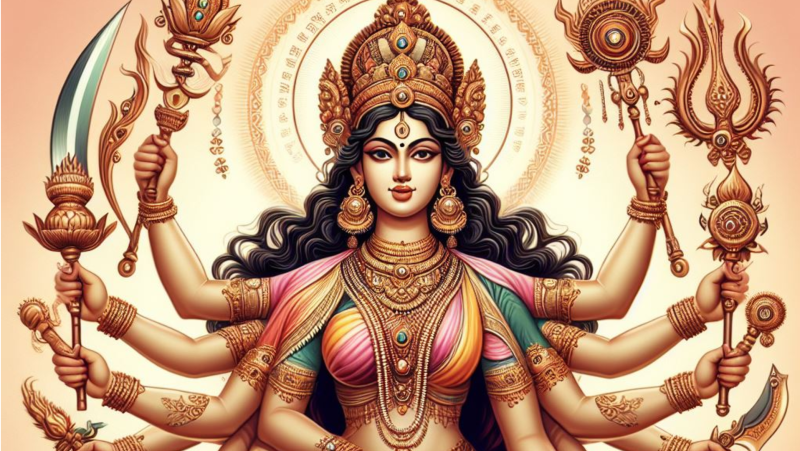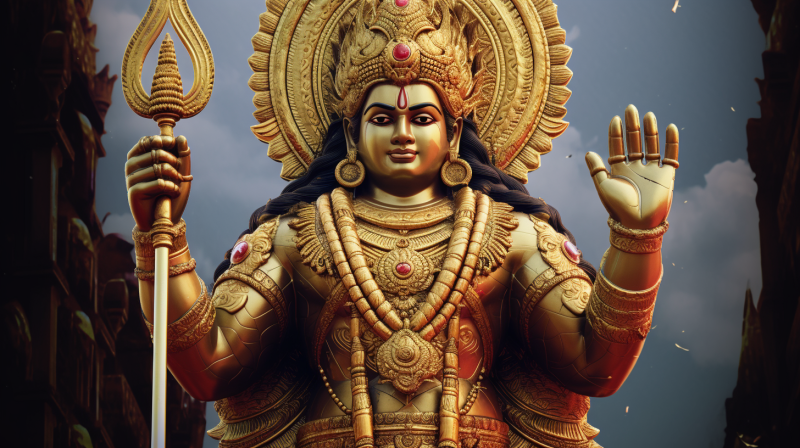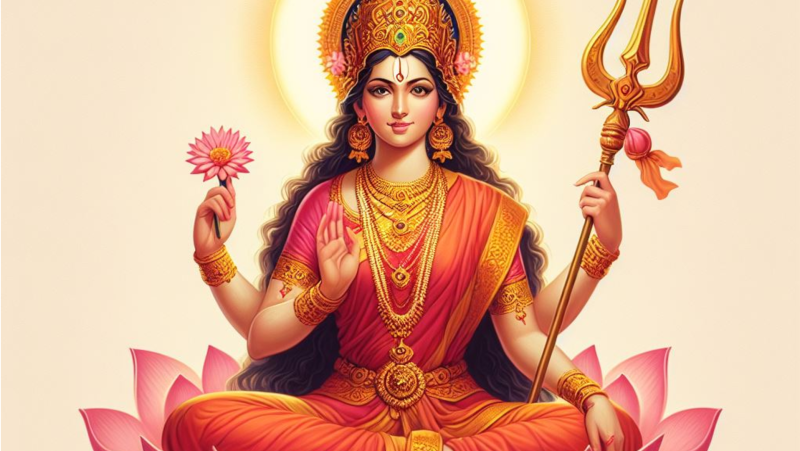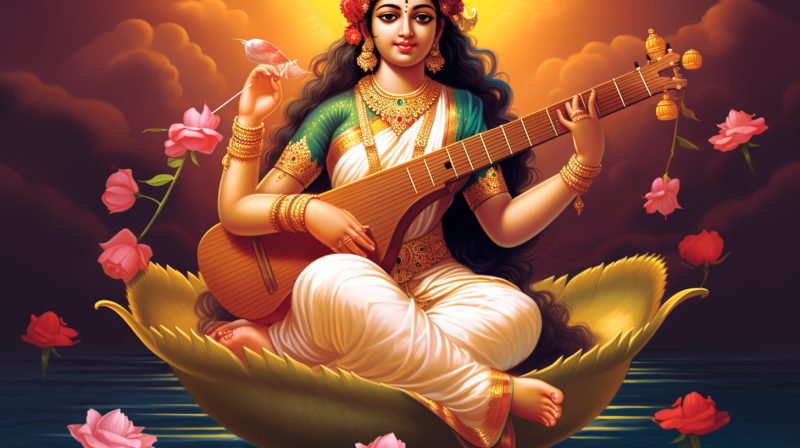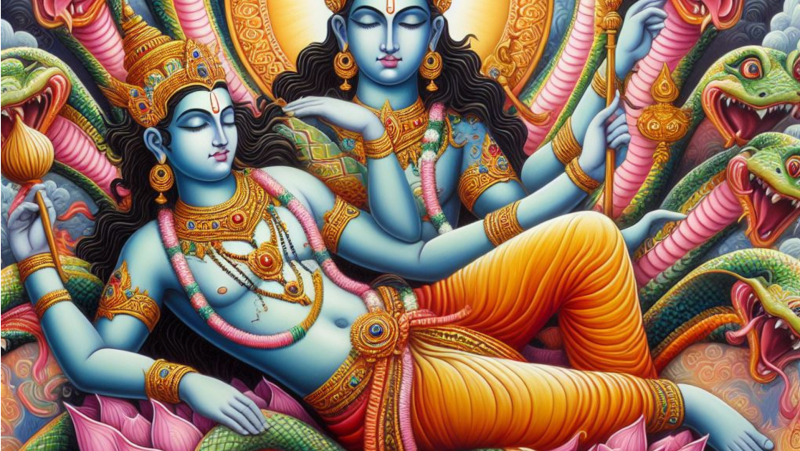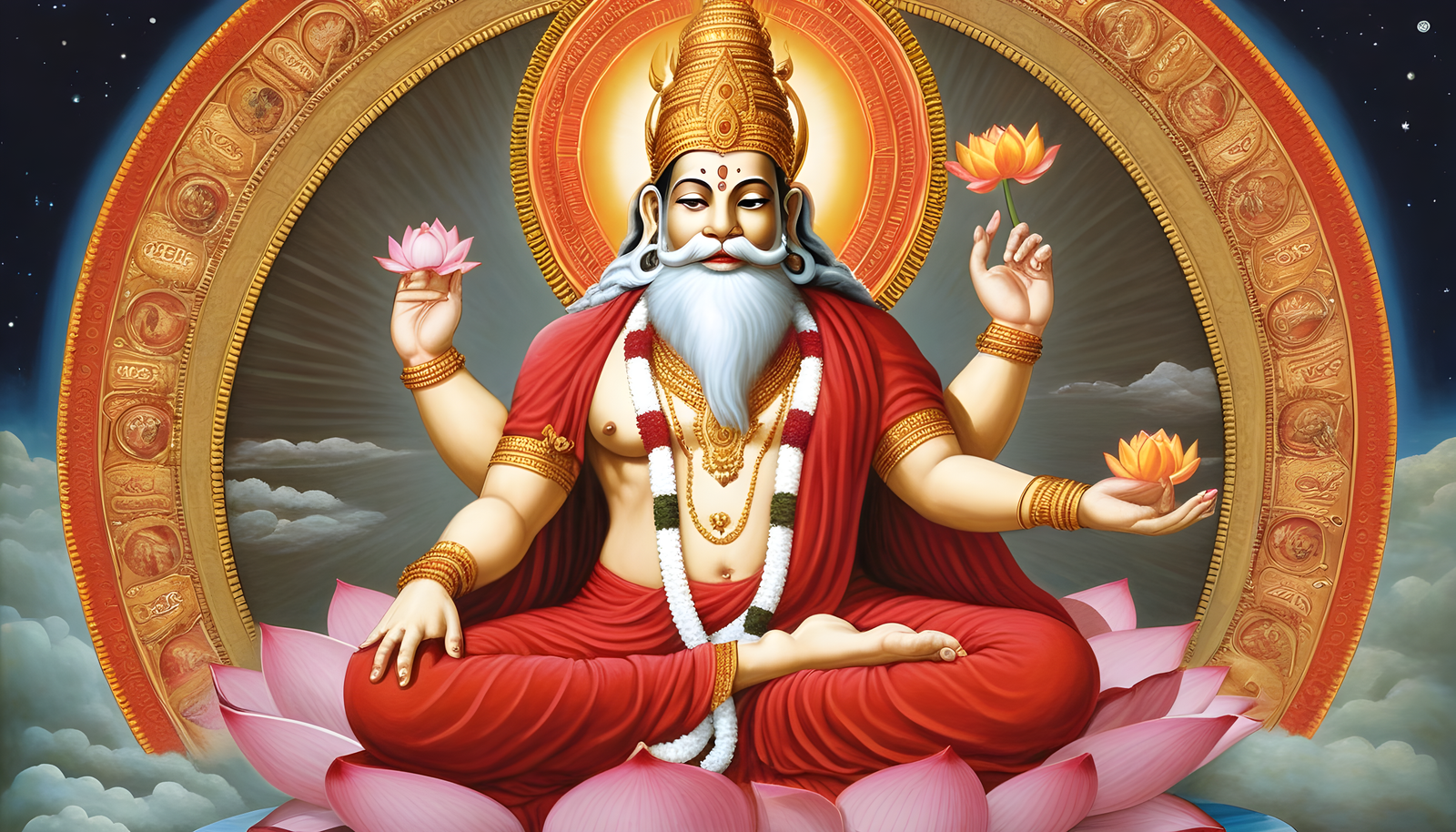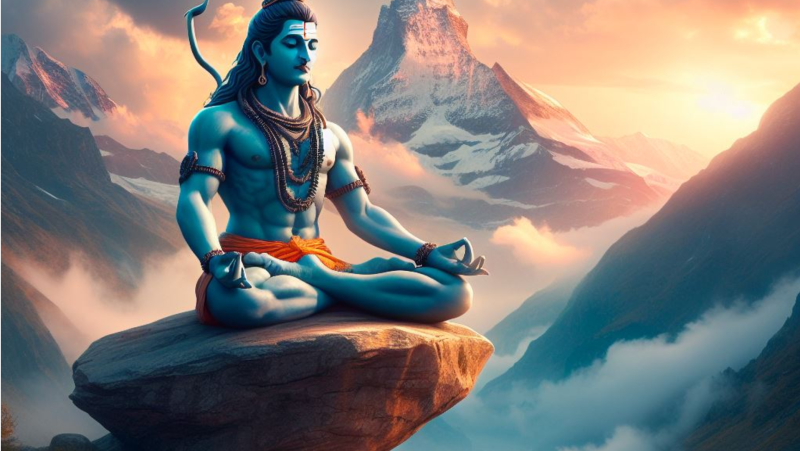
Lord Shiva, also known as Bholenath, is one of the principal deities in Hinduism, revered as the Supreme Being, the destroyer, and the transformer. Here's a comprehensive overview of Lord Shiva:
About Lord Shiva Role As Deity of Destruction and Transformation
Lord Shiva, revered as the deity of destruction and transformation in Hinduism, holds a significant place in the Hindu pantheon. Here are comprehensive details about Shiva as the deity of destruction and transformation:
1. Role as the Destroyer in the Trimurti:
• Shiva is one of the members of the Hindu trinity (Trimurti) along with Brahma (the creator) and Vishnu (the preserver).
• His role as the destroyer is essential for the cyclic process of creation, preservation, and dissolution in the universe.
2. Significance of Destruction:
• Shiva's destructive aspect signifies the dissolution of the universe at the end of a cosmic cycle, paving the way for its renewal and regeneration.
• Destruction in Hindu philosophy isn't merely annihilation but a process integral to the cycle of creation and rebirth.
3. Transformation and Rejuvenation:
• Shiva's role as the destroyer isn't solely about destruction but also transformation and regeneration.
• He signifies the cyclical nature of life, wherein destruction makes way for new beginnings and evolution.
4. Symbolism of Destruction and Renewal:
• His destructive form represents the clearing of obstacles, negativity, and illusions in one's spiritual journey, allowing for personal growth and transformation.
5. The Third Eye - Symbol of Destruction and Knowledge:
• Shiva is often depicted with a third eye on his forehead, symbolizing destruction, insight, wisdom, and the power to burn away ignorance and illusions.
• The third eye signifies divine perception beyond the physical realm and the destruction of ignorance to attain spiritual enlightenment.
6. Rudra - The Fierce Aspect:
• Shiva has a fierce aspect known as Rudra, symbolizing the destructive force capable of annihilating negativity, evil, and ignorance.
7. Cosmic Balance and Divine Order:
• Shiva's role as the destroyer maintains the cosmic balance, ensuring the continuous cycle of creation, preservation, and dissolution in the universe.
• Destruction is intrinsic to the cosmic order, allowing for the constant renewal and rejuvenation of existence.
8. Renunciation and Asceticism:
• Shiva's ascetic nature signifies detachment from material desires, symbolizing the renunciate's pursuit of spiritual liberation and transcendence.
9. Symbol of Time and Change:
• Shiva represents the passage of time and the inevitability of change. His destructive aspect underlines the impermanence of the material world.
10. Spiritual Significance:
• Devotees venerate Shiva's destructive aspect to seek the removal of impediments, spiritual growth, and transformation, embracing change for inner evolution.
Lord Shiva's role as the deity of destruction and transformation signifies the cyclical nature of life, emphasizing the necessity of change, renewal, and growth in the cosmic order. His destructive aspect is integral to the process of creation, symbolizing the transformative power of destruction for regeneration and spiritual evolution.
About Lord Shiva Attributes and Iconography
Lord Shiva, is depicted with several attributes and distinctive iconography that symbolize various aspects of his divine nature. Here are comprehensive details about Lord Shiva's attributes and iconography:
1. Matted Hair (Jata):
• Shiva's hair is portrayed as matted locks (Jata) which symbolize his ascetic lifestyle and detachment from worldly affairs.
• The flowing locks represent his wild and free-spirited nature and are associated with spiritual power.
2. Third Eye (Trinetra):
• He is depicted with a third eye on his forehead, called the "Eye of Wisdom" or "Eye of Knowledge."
• The third eye symbolizes divine insight, intuition, destruction of ignorance, and the power to perceive truth beyond the physical realm.
3. Crescent Moon (Chandra):
• A crescent moon adorns Shiva's matted hair, representing the control over time, the changing phases of life, and the divine cycle of creation, preservation, and destruction.
4. Trident (Trishul):
• Shiva holds a trident called the Trishul, which symbolizes the three fundamental aspects of existence - creation, preservation, and destruction.
• It signifies his control over the three gunas (qualities) - Sattva (purity), Rajas (passion), and Tamas (darkness).
5. Damaru (Drum):
• He carries a small drum, known as the Damaru, which represents the cosmic sound that creates the universe.
• The rhythmic beats of the drum symbolize the cosmic vibrations and the continuous cycle of creation and dissolution.
6. Serpent (Naga):
• A serpent (Naga) adorns Shiva's neck, representing his mastery over death, mortality, and time.
• It also signifies the Kundalini energy and the unification of male and female energies.
7. Ashes (Vibhuti):
• Shiva is often covered in ashes (Vibhuti), representing his renunciation and the transient nature of material existence.
• The ashes symbolize the eventual dissolution of all material forms into nothingness.
8. Deer Skin Garment (Tiger Skin):
• He is depicted wearing a deer skin or tiger skin as clothing, signifying his renunciate lifestyle and his ability to control desires and instincts.
9. Blue-Throated (Nilakantha):
• Shiva is known as Nilakantha, meaning "Blue-Throated," resulting from consuming the poison Halahala during the churning of the ocean (Samudra Manthan), which turned his throat blue.
• This act represents self-sacrifice, the control of ego, and the transmutation of negativity into positivity.
10. Trident Eye and Facial Features:
• Shiva's facial features, serene countenance, and his half-open eyes suggest meditative bliss and profound calmness.
These attributes and iconographic elements associated with Lord Shiva symbolize his various roles, powers, and philosophical significance in Hinduism. Each aspect represents an essential aspect of his divine nature, spiritual prowess, and cosmic responsibilities.
About Lord Shiva Symbolism of the Third Eye
The symbolism of Lord Shiva's Third Eye, known as the "Eye of Wisdom" or "Eye of Knowledge," holds profound significance in Hindu mythology and spiritual philosophy. Here are comprehensive details about the symbolism of Lord Shiva's Third Eye:
1. Perception Beyond Ordinary Sight:
• Shiva's Third Eye represents an extraordinary vision, beyond the limitations of physical sight. It symbolizes the perception of higher truths and spiritual insights.
2. Destruction of Ignorance and Illusions:
• The Third Eye signifies the power to destroy ignorance, illusions, and falsehoods. It represents the ability to discern between reality and the illusions of the material world.
3. Wisdom and Divine Insight:
• It embodies wisdom, divine knowledge, and insight into the cosmic truths. Shiva's Third Eye symbolizes an inner vision that transcends the boundaries of ordinary perception.
4. Control and Balance:
• The Third Eye reflects Shiva's control over the forces of creation, preservation, and destruction. It represents the balance between the material and spiritual realms.
5. Inner Spiritual Awakening:
• Opening the Third Eye symbolizes inner awakening, enlightenment, and the awakening of one's consciousness to higher levels of understanding and awareness.
6. Energy Center - Ajna Chakra:
• In yogic traditions, the Third Eye corresponds to the Ajna Chakra, the sixth primary energy center located between the eyebrows. It is associated with intuition, perception, and spiritual insight.
7. Transformation and Destruction of Ego:
• Opening the Third Eye signifies the destruction of the ego (the "I" or individual identity) to attain spiritual liberation and unity with the divine consciousness.
8. Cyclical Nature of Time:
• It represents the cyclical nature of time, where destruction is essential for transformation, renewal, and the continuous cosmic cycle of creation and dissolution.
9. Divine Knowledge and Enlightenment:
• Shiva's Third Eye symbolizes the pursuit of divine knowledge, enlightenment, and the quest for inner realization beyond the limitations of the material world.
10. Overcoming Dualities and Perception of Oneness:
• Through the Third Eye, Shiva symbolizes the transcendence of dualities, where one perceives the unity and interconnectedness of all existence.
The Third Eye of Lord Shiva embodies deep spiritual significance, representing wisdom, intuitive insight, enlightenment, and the power to transcend the illusions of the material world to attain higher consciousness and spiritual liberation.
About Lord Shiva Paradoxical Nature - Bholenath
The paradoxical nature of Lord Shiva, often revered as Bholenath, represents the multifaceted aspects of his personality and characteristics in Hindu mythology. Here are comprehensive details about Lord Shiva's paradoxical nature as Bholenath:
1. Simplicity and Compassion:
• Bholenath translates to "the Innocent Lord" or "The Simple One." Despite his immense power and cosmic role, Shiva is known for his simplicity and unpretentiousness.
• He displays a childlike innocence, often depicted as easily pleased and granting boons without assessing the worthiness of the devotee.
2. Compassion and Benevolence:
• Shiva's paradoxical nature as Bholenath also signifies his immense compassion and kindness towards his devotees.
• He readily forgives their mistakes and grants blessings, embodying the role of a benevolent and caring deity.
3. Approachability and Accessibility:
• Despite his position as a cosmic deity and the destroyer, Shiva is approachable by all, regardless of their social status, background, or deeds.
• Bholenath welcomes devotees with an open heart, showing accessibility and approachability to those seeking his grace.
4. Detachment and Renunciation:
• While known for his compassion and simplicity, Shiva also symbolizes detachment from material desires, worldly pleasures, and the transient nature of material possessions.
• His renunciate nature exemplifies detachment from the material world's illusions, emphasizing the pursuit of spiritual growth and liberation.
5. Fierce Aspect and Serene Nature:
• Shiva's paradox lies in his multifaceted aspects. He embodies both the fierce and destructive Rudra aspect and the serene, meditative, and tranquil Ardhanarishvara form.
• This duality reflects the contrasting yet complementary attributes of strength and serenity, representing the balance between creation and destruction.
6. Teacher and Yogi:
• Bholenath represents a Guru (teacher) and Adiyogi (the first yogi), sharing profound spiritual wisdom, knowledge, and the science of yoga with humanity.
• Despite his vast knowledge and wisdom, Shiva remains humble and guides seekers towards enlightenment and self-realization.
7. The Divine Childlike Innocence:
• Shiva's innocence, often portrayed in his childlike laughter and carefree demeanor, represents the purity of heart and the absence of pretense or ego.
8. Benevolent and Just Nature:
• Bholenath embodies a just and fair nature, ensuring that devotees' prayers and efforts are recognized and rewarded according to their devotion and sincerity.
9. The Simplicity of Rituals:
• His worship often involves simple rituals, emphasizing devotion and sincerity rather than grandeur or opulence.
10. Accessibility to Spiritual Enlightenment:
• Bholenath's paradoxical nature signifies that spiritual enlightenment and divine grace are accessible to all, irrespective of societal or personal status.
The paradoxical nature of Lord Shiva as Bholenath embodies a blend of simplicity, compassion, detachment, approachability, and immense cosmic power, reflecting the divine attributes that transcend human understanding.
About Lord Shiva Family and Consort - Goddess Parvati
In Hindu mythology, Lord Shiva's family and his divine consort, Goddess Parvati, play a significant role in shaping the cosmic balance and representing various aspects of creation, preservation, and dissolution. Here are comprehensive details about Lord Shiva's family and his consort, Goddess Parvati:
1. Lord Shiva's Family:
• His family includes Goddess Parvati (his consort), their sons Ganesha and Kartikeya, and other divine beings, each representing different aspects of existence.
2. Consort - Goddess Parvati (Shakti):
• Parvati, also known as Uma, Gauri, and many other names, is Shiva's divine consort and represents the feminine energy (Shakti) in the cosmos.
• She symbolizes purity, fertility, devotion, and strength. Parvati complements Shiva's male energy with her nurturing and compassionate nature.
3. Divine Union - Ardhanarishvara:
• Shiva and Parvati's union is symbolic of the Ardhanarishvara form, depicting the half-male and half-female representation, emphasizing the balance between masculine and feminine energies in the universe.
4. Marriage - Mythological Narrative:
• According to mythology, Parvati performed intense penance to win Shiva's heart. They married, signifying the harmonious union of Shiva's ascetic nature and Parvati's devotion.
5. Sons - Ganesha and Kartikeya:
• Ganesha, the elephant-headed deity, is their eldest son, symbolizing wisdom, intelligence, and the remover of obstacles.
• Kartikeya (also known as Murugan, Skanda) is their other son, revered as the god of war, courage, and victory.
6. Family Dynamics and Symbolism:
• The divine family represents various aspects of life, virtues, and cosmic roles. Shiva embodies the role of the universal father, Parvati as the nurturing mother, Ganesha as the remover of obstacles, and Kartikeya as the warrior deity.
7. Role in Hindu Mythology and Scriptures:
• Their stories and interactions are prominent in various Hindu scriptures like the Puranas and epics like the Mahabharata and Ramayana, depicting their divine roles, relationships, and contributions to cosmic events.
8. Significance in Worship and Festivals:
• Devotees venerate the divine couple through various rituals, festivals (such as Shivratri), and prayers, seeking their blessings for marital harmony, fertility, wisdom, and spiritual growth.
9. Representation of Cosmic Balance:
• Shiva and Parvati's union signifies the perfect harmony between masculine and feminine energies, emphasizing the importance of balance and complementarity in the universe.
10. Spiritual Symbolism and Union of Souls:
• The divine union of Shiva and Parvati also represents the eternal bond between the individual soul (Shiva) and the divine cosmic energy (Parvati), symbolizing the journey towards spiritual union and liberation.
Lord Shiva's family, particularly his divine consort Parvati, holds immense significance in Hindu mythology, embodying various cosmic roles, virtues, and the essence of creation, nurturing, and spiritual harmony in the universe.
About Lord Shiva As Nataraja - Lord of Dance
Lord Shiva as Nataraja, the Lord of Dance, represents the cosmic dance, symbolizing creation, preservation, and destruction within the eternal cycle of existence. Here are comprehensive details about Lord Shiva as Nataraja:
1. Cosmic Dance - Tandava:
• Nataraja embodies the cosmic dance known as the Tandava, illustrating the eternal rhythm of the universe.
• The Tandava has two forms: Ananda Tandava (the dance of bliss) representing creation and Urdhva Tandava (the dance of fury) symbolizing destruction.
2. Symbolism in Iconography:
• Nataraja's iconic depiction features Shiva standing on one leg with the other raised, portraying the dynamic and rhythmic movement of the universe.
• He has multiple arms, holding various objects such as fire (representing destruction), a damaru (drum symbolizing creation), the gesture of assurance (abhaya mudra), and the gesture pointing to his raised foot (symbolizing salvation).
3. Cosmic Balance and Harmony:
• Nataraja's dance represents the harmony and balance in the cosmos, depicting the interplay of creation and destruction, life and death, and the cyclical nature of the universe.
4. Symbol of Creation and Destruction:
• The Tandava symbolizes the creation of the universe through the cosmic dance and the subsequent destruction that paves the way for new creation, emphasizing the cyclical nature of existence.
5. Significance of the Drum (Damaru):
• The drum held by Nataraja symbolizes the primal sound of creation (Nada), representing the beginning of the universe and the cosmic vibrations that sustain it.
6. Fire and Destruction - Symbolism of Apasmara:
• The fire in Nataraja's hand represents destruction and transformation. His raised leg often crushes Apasmara, symbolizing ignorance and illusion, signifying the triumph over ignorance and the achievement of enlightenment.
7. Cosmic Order and Cosmic Energy:
• Nataraja's dance maintains the cosmic order and rhythm, signifying the cosmic energy that governs the universe's existence and dissolution.
8. Metaphysical and Spiritual Symbolism:
• Nataraja's dance represents the human soul's journey towards self-realization, liberation, and transcendence from the cycle of birth and death.
9. Art, Philosophy, and Science:
• The concept of Nataraja has inspired various art forms, philosophies, and scientific theories, portraying the cosmic dance's significance and universal harmony.
10. Worship and Spiritual Significance:
• Devotees revere Nataraja as a symbol of divine grace, seeking blessings for inner transformation, enlightenment, and spiritual growth.
Lord Shiva as Nataraja, the cosmic dancer, represents the continuous cycle of creation, preservation, and destruction, embodying the cosmic rhythm that sustains the universe and signifies the deeper spiritual truths of existence.
About Lord Shiva Festivals
Lord Shiva, is revered and celebrated through various festivals dedicated to honoring his divine attributes, cosmic role, and significance in the Hindu pantheon. Here are details about some of the prominent festivals associated with Lord Shiva:
1. Maha Shivaratri:
• Maha Shivaratri, meaning "The Great Night of Shiva," is one of the most important festivals dedicated to Lord Shiva.
• Celebrated annually in reverence to Shiva, it falls on the 14th day of the dark fortnight in the Hindu month of Phalguna (February or March in the Gregorian calendar).
• Devotees observe fasting, perform rituals, chant prayers, and visit Shiva temples, engaging in night-long vigils (jagran) and meditation to seek blessings for spiritual growth and divine grace.
2. Shravan Month:
• The month of Shravan (July-August) is considered highly auspicious for Lord Shiva.
• Devotees offer prayers, perform special pujas, and observe fasting on Mondays (Somvar) during this month, known as Shravan Somvar, to honor Shiva and seek his blessings.
3. Pradosham:
• Pradosham is observed twice in a lunar month, marking a significant period dedicated to Lord Shiva.
• It occurs on the 13th day of both the waxing (Shukla Paksha) and waning (Krishna Paksha) phases of the moon.
• Devotees perform special prayers, visit Shiva temples, and participate in rituals to seek Lord Shiva's grace and blessings.
4. Kartik Purnima:
• Kartik Purnima, the full moon day in the Hindu month of Kartik (October-November), holds significance for Lord Shiva.
• Devotees take holy baths in rivers or sacred water bodies, visit Shiva temples, and perform rituals to honor Shiva on this auspicious day.
5. Shiva Ratri in Shravan:
• In addition to Maha Shivaratri, many regions celebrate a Shivaratri during the Shravan month (July-August), focusing on various legends associated with Lord Shiva.
6. Annually on the Day of Shiva's Wedding:
• Some devotees also celebrate the anniversary of Shiva's wedding to Goddess Parvati, known as Shiva Parvati Jayanti, with special prayers and rituals.
During these festivals, devotees observe traditions such as fasting, offering Bilva leaves, performing abhishekam (ritual bathing of the Shiva lingam), chanting mantras, singing bhajans (devotional songs), and seeking Lord Shiva's blessings for inner peace, prosperity, and spiritual enlightenment.
Different regions may have additional festivals dedicated to Lord Shiva, each with unique customs and traditions that glorify the divine attributes and cosmic significance of the deity.
About Lord Shiva - Universal Significance
Lord Shiva, holds universal significance transcending religious boundaries and cultural contexts. Here are comprehensive details about the universal significance of Lord Shiva:
1. Symbol of Transformation and Creation:
• Shiva represents the cycle of creation, preservation, and dissolution in Hindu cosmology.
• His cosmic dance symbolizes the eternal rhythm of the universe, signifying the continual process of creation and transformation.
2. Spiritual and Philosophical Essence:
• Shiva embodies spiritual transcendence, symbolizing the ultimate reality (Brahman) beyond physical existence. His essence lies in spirituality, meditation, and enlightenment.
3. Unity in Diversity:
• Lord Shiva's worship extends beyond boundaries of caste, creed, and nationality. He unites people from diverse backgrounds, emphasizing the oneness of humanity.
4. Spiritual Liberation (Moksha):
• Devotees revere Shiva for his role as a yogi, teacher, and liberator, guiding seekers towards self-realization and liberation (moksha) from the cycle of birth and death.
5. Cosmic Balance and Harmony:
• Shiva's cosmic roles as the destroyer and preserver maintain balance in the universe, symbolizing the harmonious coexistence of creation and destruction.
6. Relevance in Various Traditions:
• Beyond Hinduism, Lord Shiva's teachings and philosophy resonate with seekers of truth and spiritual enlightenment in various spiritual traditions globally.
7. Inspiration in Arts and Culture:
• Shiva's imagery, symbolism, and cosmic significance have inspired art, literature, dance, music, and cultural expressions worldwide, transcending religious affiliations.
8. Meditative and Philosophical Aspects:
• Shiva's meditative state signifies inner peace, self-awareness, and introspection, encouraging spiritual seekers to delve into their inner realms for self-discovery.
9. Importance in Yoga and Meditation:
• Shiva is regarded as the Adiyogi (the first yogi) and the supreme guru, imparting the knowledge of yoga and meditation to humanity.
10. Transformation and Transcendence:
• Lord Shiva represents transformation, encouraging individuals to transcend the limitations of the material world and embrace higher consciousness.
Shiva's universal significance lies in his embodiment of timeless wisdom, spirituality, cosmic balance, and the pursuit of self-realization. His teachings resonate with seekers of truth, spiritual growth, and enlightenment, transcending boundaries of religion and culture.
You may also like …
Are You The Proud Hindu?
The Trimurti
Create an account to join us and start taking part in conversations.
SIGNIN